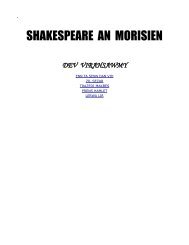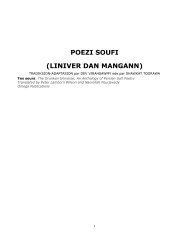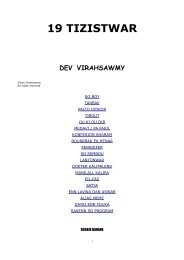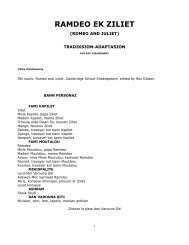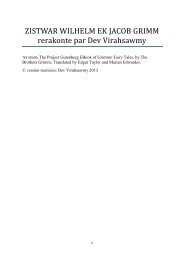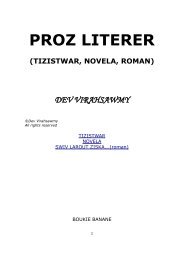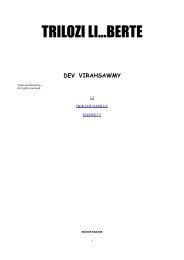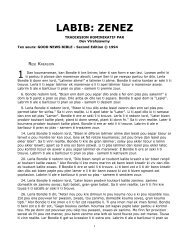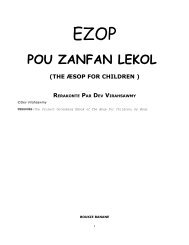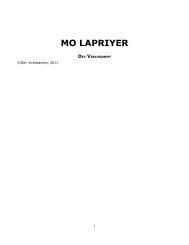LITERESI BILENG AVANSE - boukie banane
LITERESI BILENG AVANSE - boukie banane
LITERESI BILENG AVANSE - boukie banane
You also want an ePaper? Increase the reach of your titles
YUMPU automatically turns print PDFs into web optimized ePapers that Google loves.
YESTERDAY, TODAY AND TOMORROW<br />
What is Mauritius? An exotic touristic destination? Yes, but much more. A small island state which is thriving in<br />
the midst of general economic downturn? Yes, but much more. What is it then?<br />
It is a Creole Island as defined by Professor Megan Vaughan in her book Creating the Creole Island: Slavery in<br />
Eighteenth Century Mauritius (Duke University Press, 2004). By 'creole' she means that the island, without<br />
natives, has been “the product of multiple influences, multiple sources, which to differing degrees merge, take<br />
root, and 'naturalize' on this new soil.”<br />
It has been frequently hypothesized that Mauritius was first discovered by the Arabs, who named the island<br />
Dina Arobi. The first historical evidence of the existence of an island now known as Mauritius is on a map<br />
produced by the Italian cartographer Alberto Cantino in 1502. It is sure that Mauritius was visited by the<br />
Portuguese between 1507 and 1513. The Portuguese took no interest in this isolated island, however. Their<br />
main African base was in Mozambique, and therefore the Portuguese navigators preferred to use the<br />
Mozambique Channel to go to India. The Comoros at the north proved to be a more practical port of call. Thus<br />
no permanent colony was established on the island by the Portuguese.<br />
Dutch colonization started in 1638 and ended in 1710, with a brief interruption between 1658 and 1666.<br />
Agriculture was organised with the introduction and cultivation of tobacco, indigo, maize and sugar cane.<br />
Hunting was also possible with the introduction of deer from Java. Ebony trees were hewed down for export.<br />
Numerous governors were appointed, but continuous hardships such as cyclones, droughts, pest infestations,<br />
lack of food and illnesses finally took their toll, and the island was definitively abandoned in 1710. In the<br />
meantime they had decimated the local dodo and giant tortoise population for food and had introduced<br />
competing species and pests, sometimes involuntarily. According to certain historians dodo flesh was not really<br />
appreciated. The bird became extinct because it laid its egg on the ground and rats from dutch ships found a<br />
ready supply of good food.<br />
After the departure of the Dutch in 1710, Guillaume Dufresne D'Arsel, while on the route to India, landed in<br />
Mauritius in September 1715 and claimed the island for France. He named Mauritius 'Ile de France'. However it<br />
was only in 1721 that the French started their occupation of the island. But real progress on their settlement<br />
started only as from 1735 with the arrival of the most illustrious of French Governors, Bertrand François Mahé<br />
de Labourdonnais. Under Mahé de Labourdonnais, Port Louis on the northwest coast became the principal<br />
harbour of the island. With the help of slaves, sugar cane cultivation became a full-blown success. Roads<br />
(linking Port Louis to other parts of the island), barracks, office buildings, mansions and houses were built<br />
rapidly in order to accommodate the growing prosperity of the island.<br />
The French cleared the indigenous forests to make way for intensive cultivation of sugarcane, brought in slaves<br />
mainly from Mozambique and Madagascar. In December 1810 the British landed on the north of Ile de France<br />
and captured the island from the French after a fierce battle. The British brought in indentured labourers from<br />
India. These successive waves of immigration transformed the flora and fauna of the island making the island a<br />
9



